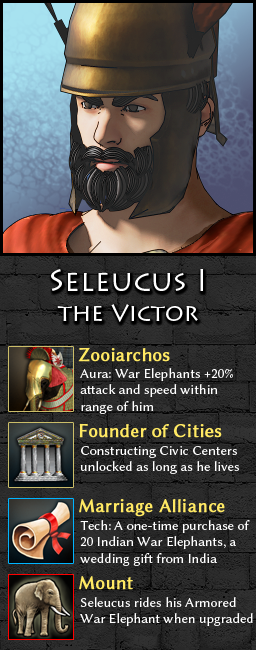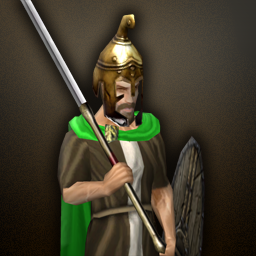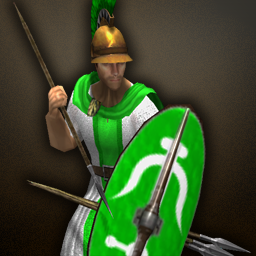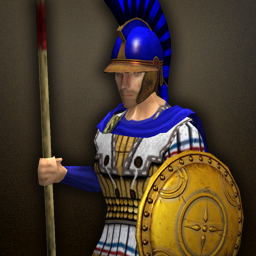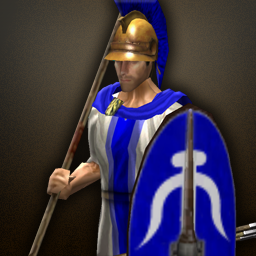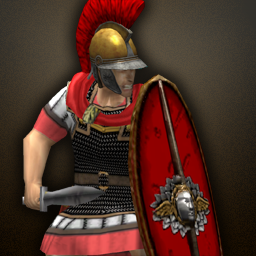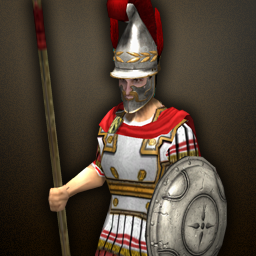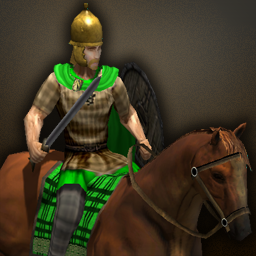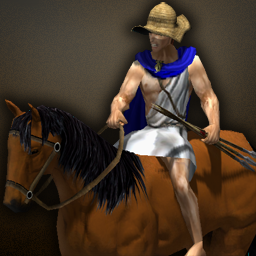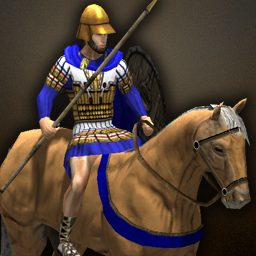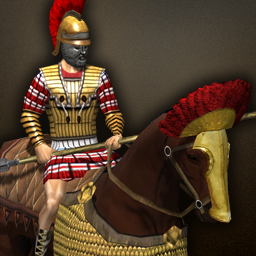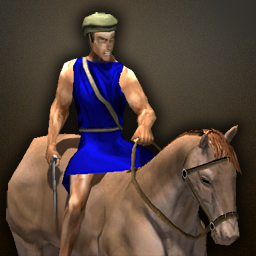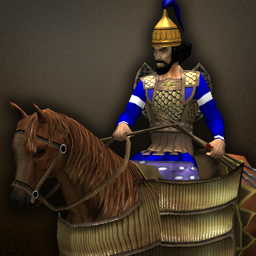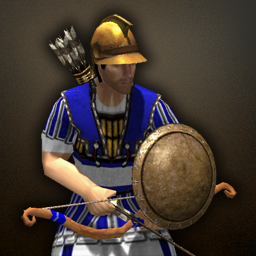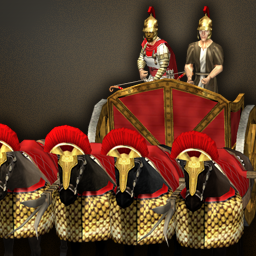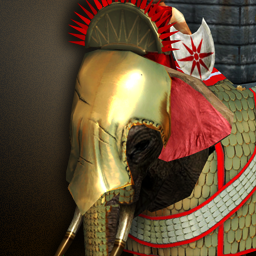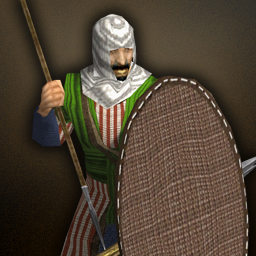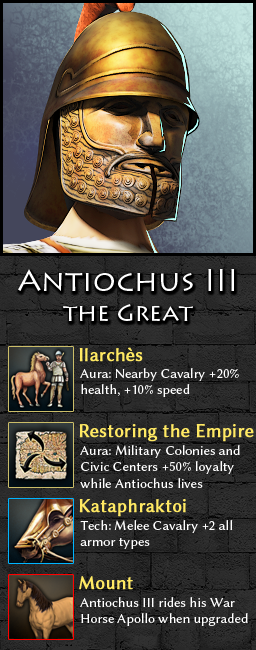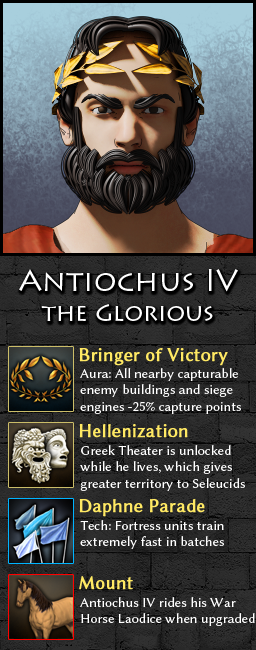Leaderboard
Popular Content
Showing content with the highest reputation on 2020-08-04 in all areas
-
3 points
-
Yass please. Garamantes and Numidians? That would basically cover Africa for our time period. I like this! I might experiement.3 points
-
Personally, I'm against the idea of combining civs and against the idea of civ brackets/tiers. I think we are all thinking about this is the wrong way. We don't need to be thinking about the factions as a group. In fact, that's the one aspect of this game we should be ignoring. Scenario Think of a matchup between Britons and Seleucids. Each faction is quite different from one another. However in this matchup, it is not very important to compare the two civilizations in terms of historical accuracy. We should be comparing them based on the environment. Each culture developed a style of warfare that best suited their environment In a heavy wooded map, the more flexible Britons have an advantage over the large and clumsy formations of the Seleucids, but in an grassland, the tables flip. Now the powerful Seleucid formations and cavalry would shred the Britons. Conclusion We need to be thinking more about the environment that we put the civilizations in. More deliberate map design, with areas that all factions can excel in. Currently, our maps are based on locales, which is hindering balance by favoring the native culture. Thinking about the scenario above, imagine a map with both heavily wooded areas, and open areas/ pathways. Now the question doesn't become which faction is better, it becomes a question of how well can each player utilize the map! How well can they force engagements on terrain that favors them? Obviously we would still need to keep an eye on the exact stats of techs and units for each faction, but if we build the maps right, we can still allow these unique matchups that make this game great! Open areas for the more formation focused civs, wooded areas/rough terrain for more flexible civs. Flat areas for cavalry civs, and terrain height for ranged based civs. Most RTS titles focus on how well you can micro your economy and armies, but map utilization is rather minor. Players usually play "on" the map instead of "with it!" This is what could give 0AD an identity and make it unique from other RTS titles! As an added bonus, it would allow for more factions to be added without making balancing a nightmare! Addendum Now, we still need to consider the factions as individuals. I'm of the opinion that we should make sure that each one feels unique. We don't need Starcraft-ien levels of unique, but think AOEIII WOL mod levels of unique. Each faction should have a preferred playstyle and a preferred unit roster, and it's out goal as balancers to make sure to emphasize these preferences. Spartans should be a infantry heavy faction, Carthage should play defensively, Kush can build tall, and the Seleucids can build wide. By emphasizing these preferences, players can really get a feel for the differences of each faction, and they can find the one that matches their playstyle. This can be done through more unique techs, faction bonuses, and possibly with re-thought rosters. Combining all these thoughts would make this game a great game of tactical skill. The player must not only take advantage of their civ's unique strengths and understand their weaknesses, but use the map and the environment to help make sure they fight on their terms.2 points
-
To be precise, I am personally against the idea to build groups based on history and general strategical guidelines and to stick with those to balance the civs. I understand that the civs belongs to the same conceptual groups due to their design, because in the way we design a faction we are constrained by historical evidences. So it is logical that the Iberians, the Britons and the Gauls have several similarities in their strategies. Because historically they had. It is logical that Macedonians, Seleucids and Ptolemies have several similarities as well. But I am against the idea to balance the civs only with their similar counterparts. If the Iberians, the Britons and the Gauls are only balanced in regard to each other, then it will probably result to unbalance when players of those civs will face other civs from other groups. Because let's face it, it would be the case regularly. So I suggest those grouping should be different according to their goals. I agree to group the civs between them according to their similarities and history when it is done with the purpose to draw the general kind of strategies and gameplay. Like in Wijitmaker proposal with thematic group. But when it is grouping in the purpose of balancing the civs, it should be mixed groups. Because it is not directly the civs that are unbalanced but some general strategies that are far better than others. As I said, I agree with your observation that 78 matchups to balance is too much. I agree with your idea to balance the civs only in their own group. I simply don't see the relevance to balance a civ only against a similar civ.2 points
-
I know the Nubas are only a mini faction, but their villages look really nice and i could see them as becoming more important if they are left with some handicaps, perhaps. For example, they could have naturally stronger units(perhaps by 10%?), and cheaper CC's, but have far less upgrades available to them. Speaking of capturable tech trees, this could work well together, as the Nubas would be stronger, but the upgrades of your starting civ could apply to them, which would make them sought after mercenaries. It would be a consistent way to look at the capturable Nuba mercenary camps. PS. I'm glad to see you have added the military infantry trainable in their CC now :-) It was hard winning with just Scout Cavalry :-p2 points
-
This is an idea I've had for a while now (couple of years maybe?)... Original text in spoiler: Proposal below: Our civilisations are currently supposed to be balanced. Picking a random civilisation should, on average, give you a fair chance to win assuming equal skill. Since we now have 13 civilisations, that means we need to balance 78 matchups. This is a considerable amount, particularly since we actually have limited manpower, particularly for gameplay purposes. In my opinion, we only have 2 ways to balance so many matchups: Effectively reduce the # of civs (e.g Celt, Greek, Roman, Kushites), by making the different "sub-civs" very similar. This precludes adding too many different groups, or we have to add "trash" civs. Effectively make all civs very similar. We can't get AoE2 level of variety because our tech tree/unit tree is much too small. So we're reduced to making them all basically equivalent. I like neither of these options. My proposal is to split our civilisations into groups, and only balance inside a given group. What I mean is that any matchup inside a group should give you a fair chance of winning - but matchups across groups (say, below, Roman vs Kushites) could be terribly unbalanced - or could not be. Romans might have one unit or one strategy that Kushites can't counter for example. Below is a Group List (proposal with some quick reasoning). My criteria are, to some extent, chronological and geographical. I am also picking what I think would be interesting matchups. Superpower Group - the 3 largest empires in the relevant timeframe Macedonians - Under Alexander the Great, circa 330 BC, they conquered most of what I will call the then "civilised" world. Obvious pick. Aechemenid Persians - While Cyrus II is technically out of our date range, he's in the game files, and it makes fine gameplay to have Macedonians and Persians in the same group since they did fight. Mauryas - Under Chandragupta, became one of the largest empires — period — back then. These 3 together also form a continuum of Greek-Indian empires and are historically somewhat tied. I think they make up an interesting group. Mediterranean Civs - More naval oriented Romans - Since we are pre-marian, this is the Rome of the punic wars. Stronger in terms of naval power than we might think, not yet mingling with the gauls up North too much. Carthaginians - Foil to the Romans at the time, we need them in the same group for historical play reasons. The question is "who next?". I think we might put Athens, a strong naval city state, but they did not really wage war on each other too much. Alternatively, Iberians were conquered by Rome by 100BC, so they could be put here. I'm having a hard time putting Athens somewhere more relevant, because as a strongly Naval civilisation they would be easily unbalanced against "land-based" greek civs, and they're historically not really relevant against anyone but these same greek states. Athens/Iberians Aegean Civs - more land-based civilisations perhaps. Spartans - land-based, which makes them good to fight the two other successor states. Seleucids - Successor state in the region, that mingled with Ptolemy Ptolemaic Egyptians - likewise. Celtic Civs I'm grouping these here because they were relatively similar, and thus would be relatively easier to balance. To be honest, we could perhaps move them all alongside the "Rome" group, particularly if we put Iberians there. The trouble is that they didn't really fight many of the other civilisations from our time-range. We could also dispatch one celtic civ in each other group, for variety, but that throws historical realism somewhat out the window and might complicate balancing. Gauls Ibers Britons Unbalanced Civs - those that aren't in a group (yet/ever?) Kushites ---- The advantages of this are: We need to balance fewer matchups. With easier balance, we can make civs more diverse, possibly more historically accurate. Currently, and particularly in A24, we've made civs very similar as balancing is hard. It makes it possible to highlight some different matchups. It also makes it possible to add more civilisations - we don't need to consider the overall balance. As such, a Mesoamerican group can easily be added, like wise for Asian civs. The drawbacks, obviously, are that MP users would have a reduced # of picks, and that it needs some development to support.1 point
-
To continue the debate: And another important contribution from Nescio: So there are evidences for a large variety of siege engines one or two centuries after the Mauryas. It is not perfectly on the good time frame and possibly some exchange and development have been in place after the Mauryas but they could be a heritage from the Mauryas as well. What we do with this information? Nescio, you beat me for a few seconds ahaha Edit: furthermore the weird "cartwheel-shaped" ballista/catapult is not really a description matching Roman or Greek examples at my knowledge. It seems to be a torsion engine using some kind of wheel or wheelS, to hurl stones. Edit2: some kind of springald catapult? Edit3: or something like this trebuchet/mangonel? lol Edit 4: Or something much simpler (and much more credible):1 point
-
1 point
-
The number of naive matchups between civilizations is Sumi(n-1)i, where n=number of civilizations. with 3 civs, 2 + 1 = 3 matchups with 4 civs, 3 + 2 + 1 = 6 matchups with 5 civs, 4 + 3 + 2 + 1 = 10 matchups with 13 civs(v24) = 78 Matchups However If you match up similar factions internally, then test only that "general faction" against the others. You will reduce this number significantly. Celts(brit, gaul): 2 Matchups Greeks(athen, mace, spart): 3 Matchups Successor(sele + ptol): 1 Matchups I'm not sure if we can group the following, so we may need to treat them separately: Carthaginian, Iberian, Kushites, Mauryans, Romans, Persians Because we can group some civs together, we have reduced the number of global matchups considerably. 6 Independent Civs, Plus 3 general cultures. That means 9 global matchups. 9 Global matchups results in 36 possible combinations, then we add the internal culture matchups, 36+2+3+1=42. So practically speaking we only need to worry about 42 possible matchups, not 72. If we can categorize two of the independent civs i mentioned together, there will only be 8 global matchups, and total will reduce to 34.1 point
-
@vinme Rationale for civ ratings unclear, please describe the thought process and calculations performed (in a single paragraph if possible). The 0ad community thanks you.1 point
-
Yeah, I was originally going to talk about catapults but I did a little research before and discovered the 'catapults' from the Magadha dynasty, didn't find reference about bolt shooters so that's why I referenced them, thanks for the info!1 point
-
That's a really good idea.I wonder if we could have the concept of a "mixed" population too? A conquered CC could produce partly units from one Civ, and partly units from another Civ.1 point
-
https://github.com/JustusAvramenko/delenda_est/commit/3af13defe65b35e520d3842c92fbdab5fa46a9ad After the above commit, Citizens and Citizen Soldiers can now lay and construct all buildings available to that civ. I've playtested this and it's good. Furthermore, that commit and a previous one makes it so that if you capture an enemy Civic Center you can then train the enemy's citizens. So, if you are Sparta and you capture a Kushite CC, then you can train Kushite Citizens. Now, if you train that Kushite Citizen, most of the buildings they lay will by Spartan, except for Temples, Statues, and Wonders. Those will be Kushite. So, by capturing enemy CC's you can now mix and match some cultural structures. This is experimental for now. I may expand the list of native buildings the captured Citizens construct, or I might remove that completely. We'll see.1 point
-
1 point
-
1 point
-
In DE I made the skiritai into fast hoplites instead of swordsmen. In that way they're a lot like the Eagle Warriors from AOK.1 point
-
Indeed, the debate is nothing new, it started already in the late 19th C, and it will probably continue until 2300-year-old elephant bones suitable for proper DNA analysis (both nuclear and mitochondrial) show up in Egypt on the one hand, and on the other in Tunisia, Algeria, Morocco, Spain, Sicily, or Italy. What's also fascinating is that the forest elephant hypothesis does not solve all issues, and various old suggestions resurface from time to time. Yes, I read that article too. Basically the author is saying that the notion that Indian elephants are bigger is a topos (a literary commonplace), which is not as far-fetched as it may sound to non-classicists; topoi are actually quite common. Moreover, Schneider 2016 is not the first to propose it (see Tarn 1926). Furthermore, assuming that Ptolemaic war elephants were forest elephants does not make Polybius unproblematic. First he writes 5.84.2–4: [2] ὀλίγα μὲν οὖν τινα τῶν παρὰ Πτολεμαίου συνήρεισε τοῖς ἐναντίοις· ἐφ᾽ ὧν ἐποίουν ἀγῶνα καλὸν οἱ πυργομαχοῦντες, ἐκ χειρὸς ταῖς σαρίσαις διαδορατιζόμενοι καὶ τύπτοντες ἀλλήλους, ἔτι δὲ καλλίω τὰ θηρία, βιαιομαχοῦντα καὶ συμπίπτοντα κατὰ πρόσωπον αὑτοῖς. [3] ἔστι γὰρ ἡ τῶν ζῴων μάχη τοιαύτη τις. συμπλέξαντα καὶ παρεμβαλόντα τοὺς ὀδόντας εἰς ἀλλήλους ὠθεῖ τῇ βίᾳ, διερειδόμενα περὶ τῆς χώρας, ἕως ἂν κατακρατῆσαν τῇ δυνάμει θάτερον παρώσῃ τὴν θατέρου προνομήν· [4] ὅταν δ᾽ ἅπαξ ἐγκλῖναν πλάγιον λάβῃ, τιτρώσκει τοῖς ὀδοῦσι, καθάπερ οἱ ταῦροι τοῖς κέρασι. Only some few of Ptolemy's elephants came to close quarters with the foe: seated on these the soldiers in the howdahs maintained a brilliant fight, lunging at and striking each other with crossed pikes. But the elephants themselves fought still more brilliantly, using all their strength in the encounter, and pushing against each other, forehead to forehead. The way in which elephants fight is this: they get their tusks entangled and jammed, and then push against one another with all their might, trying to make each other yield ground until one of them proving superior in strength has pushed aside the other's trunk; and when once he can get a side blow at his enemy, he pierces him with his tusks as a bull would with his horns. Which is followed by 5.84.5–6: [5] τὰ δὲ πλεῖστα τῶν τοῦ Πτολεμαίου θηρίων ἀπεδειλία τὴν μάχην, ὅπερ ἔθος ἐστὶ ποιεῖν τοῖς Λιβυκοῖς ἐλέφασι· [6] τὴν γὰρ ὀσμὴν καὶ φωνὴν οὐ μένουσιν, ἀλλὰ καὶ καταπεπληγμένοι τὸ μέγεθος καὶ τὴν δύναμιν, ὥς γ᾽ ἐμοὶ δοκεῖ, φεύγουσιν εὐθέως ἐξ ἀποστήματος τοὺς Ἰνδικοὺς ἐλέφαντας· ὃ καὶ τότε συνέβη γενέσθαι. Now, most of Ptolemy's animals, as is the way with Libyan elephants, were afraid to face the fight: for they cannot stand the smell or the trumpeting of the Indian elephants, but are frightened at their size and strength, I suppose, and run away from them at once without waiting to come near them. Note Polybius' cautious “I suppose” (ὥς γ᾽ ἐμοὶ δοκεῖ), though. If the Ptolemaic elephants were indeed forest elephants, then 5–6 makes sense: forest elephants are certainly smaller than Indian elephants. However, then 2–4 becomes problematic: Ptolemy's elephants were clearly large enough to carry turrets (!) and to match Antiochus' Indian elephants forehead to forehead (συμπίπτοντα κατὰ πρόσωπον αὑτοῖς). Gowers 1948, Gowers and Scullard 1950, and Scullard 1974 (yes, the two advocating war elephants were forest elephants) suggest that Ptolemy IV may have had not only forest elephants (which refused to fight and fled), but also some Indian elephants (which were the ones that did engage Antiochus' elephants). Charles 2007 argues this is not only a possibility, but actually the most likely explanation. Moreover, Ptolemy's (few) Indian elephants would have had turrets, but not his forest elephants (the majority). Charles concedes other scholars believe Ptolemy IV had no Indian elephants: Moreover, in his 2016 article, written in response to the 2014 Eritrean elephants genetic study, Charles gives the following possibilities: Ptolemy had only forest elephants, those that engaged the Indians were older, larger males. Ptolemy had mostly forest elephants (which were afraid), but also a few Indians (which did fight). Ptolemy had mostly forest elephants (which were afraid), but also a few bush elephants (which were much larger and fought). In this case the forest elephants would be those from Τρωγοδυτική in the Adoulis inscription and the bush elephants would be from Αἰθιοπία. Ptolemy had only bush elephants, but most were too young or too poorly trained and refused to fight. Unlike in 2007, he now dismisses scenario 2, stating that it's unlikely any Indian elephants of his predecessors would still be alive under Ptolemy IV. This leaves scenarios 1, 3, and 4. Scenario 1 could work, especially if “some of the Seleucid Indians were not fully grown, and were therefore a better match for adult forest elephants”. Scenario 3 is problematic, if the Ptolemies had access to both forest and bush elephants, why would they bother catching inferior forest elephants, when bush elephants would offer a very real military advantage over the Seleucids? Scenario 4 is supported by the recent DNA research, but is at odds with the notion that Indian elephants were bigger than African elephants in Antiquity, and if the Ptolemaic elephants were bigger, then it raises the question why they failed to defeat the Indians. In the end Charles favours scenario 1. (Unlike him, my order of preference is 4, 2, 1, 3. ) To end this post, I'd like to point out another article by Charles, written only two years later: Michael B. Charles “The Elephants of Aksum: In Search of the Bush Elephant in Late Antiquity” Journal of Late Antiquity 11.1 (2018) https://doi.org/10.1353/jla.2018.0000 In it he entertains the idea that the Aksumites may have had at least one bush elephant, the one that was shipped across the sea to attack Mecca, in what became afterwards known as the “Year of the Elephant” (it's date is disputed, somewhere between AD 550 and 570), and even got a surā in the Qurān named after it. However, that's beyond our timeframe. The reason I'm mentioning it is to illustrate that bush elephants as war elephant is gradually becoming an acceptable possibility, even among scholars who earlier accepted Gowers and Scullard's view of only forest elephants. That's it for today, I hope you like it.1 point
-
1 point
-
I made 'em In some cases its a salesman from my previous work. He yelled in to my phone and i paid him 2 Mcchicken sandwiches for all rights in perpetuity. He probably got the better end of the deal.1 point
-
Did you create another account?0 points


.thumb.jpg.b21ca1d0c15fb56b42c39b25a0a40815.jpg)



